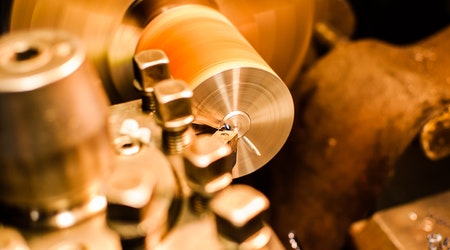Putting Motor Technology to Work
Properly specified and maintained, new-generation motors offer benefits related to energy efficiency and performance
Electric motors account for nearly one-half of all electric use in the United States, and they have a substantial impact on the total energy costs in institutional and commercial buildings. Given today’s high energy prices, the cost to buy a commercial motor is not nearly as significant as the costs associated with operating that motor for hundreds and even thousands of hours annually.
Effectively managing motors is imperative for maintenance and engineering managers seeking to improve reliability, reduce energy use and find cost savings. A number of tactics can help managers achieve this goal — taking advantage of current motor technologies, employing maintenance and inspection procedures, implementing a motor management plan, and taking advantage of incentives for efficient equipment offered by electric utilities and other administrators of ratepayer funded energy-efficiency programs.
Together, they form a cost-effective strategy for reducing the impact that energy use by commercial motors has on a facility’s bottom line.
Premium Efficiency Motor Technology
Many motors in commercial settings operate constantly, generating thousands of hours of use per year. Installing the most efficient motor available will lead to significant energy and cost savings, as well as improved reliability and a smaller environmental impact.
In 1992, the federal government established minimum efficiency levels for electric motors manufactured after October 1997, but many products on the market greatly exceed that minimum, including motors that exhibit so-called “premium efficiency.”
In 2001, the National Electrical Manufacturers Association (NEMA) established a specification for premium efficiency motors known as NEMA Premium™. This standard defines the minimal efficiency requirements a manufacturer must meet to use the NEMA Premium label on their motor.
Qualifying motors are up to 4 percent more efficient than the mandatory federal minimums, and the often often are made with superior materials and improved manufacturing processes. NEMA efficiency specifications apply to the design, speed and enclosure type for three-phase electric induction motors. There are four types of NEMA motor designs:
-
General-purpose motors, which are used in most applications, including fans and pumps; identified as category B
-
general-purpose motors with a slightly higher torque; category A
-
motors requiring a high starting torque for use in conveyor belts or compressors; category C
-
high-torque, high-slip motors used for manufacturing operations, category D.
NEMA Premium motors fall into design categories A and B. They include speeds of 3,600 revolutions per minute (rpm), 1,800 rpm and 1,200 rpm, and the range from 1- 500 horsepower.
NEMA motor enclosures are designated as open and totally enclosed. The motors most commonly found in institutional and commercial settings are open drip-proof units, with ventilation preventing particles and water from seeping into the motor from above. The most common enclosed motor design is a totally enclosed fan-cooled motor that draws air over the motor case to cool it.
NEMA Premium motors have:
-
thinner steel laminations, which decrease eddy current losses
-
more copper wire and larger diameters in the stator to save energy by reducing resistance in the stator winding
-
larger conductive bars and end rings to reduce losses from rotor resistance
-
modified stator-slot design to decrease magnetic losses and make room for larger diameter wire
-
longer stators to lower magnetic density and increase cooling capacity, reducing magnetic and load losses
-
more efficient design for the cooling fan, which increases airflow and reduces power needed to drive the fan
-
premium-grade steel cores reduce hysteresis power loss.
These characteristics of premium efficiency motors contribute to improved reliability, decreased energy use and increased cost savings. According to MotorUp, a Northeast regional outreach program initiated through Northeast Energy Efficiency Partnerships (NEEP), a typical 20 horsepower (hp) electric motor running continuously at full load costs more than $14,000 per year to operate.
Replacing it with a premium efficiency motor can save an organization more than $300 every year on electric power at a cost of $0.10 per kWh. Also, a typical 100 hP motor operating at continuous full capacity, costs more than $70,000 per year to run. Using a premium efficiency motor in this instance saves about $1,400 each year.
Maintenance Considerations
In addition to selecting the most efficient motor equipment available, proper maintenance is critical for managing energy costs and improving motor reliability. Opportunities to increase motor efficiency through maintenance arise in transmission systems, or belts, equipment lubrication, and system-maintenance practices.
Although V-belts most commonly connect motors to their loads, three other belts might offer greater efficiency, according to the American Council for an Energy Efficient Economy (ACEEE).
Among them are cogged V-belts that last twice as long and require less frequent adjustments. Flat and synchronous belts also might improve motor efficiency. ACEEE cites several studies that replaced V-belts with cogged V-belts. The results were a median energy savings of 4.1 percent, at which level the payback ranged from one to five months.
Maintaining the lubrication of a motor also can improve its efficiency and reliability by increasing resistance to deterioration and extending equipment life. The ACEEE report found that proper lubrication can lead to energy savings of 3-20 percent in gear reducers, compressors, and motors. The report also cautions against mixing lubricants and overlubricating, instead encouraging managers to follow the recommendations of the motor manufacturer.
Finally, adjusting maintenance procedures to detect the conditions that can lead to a motor failure also improves reliability and prevent a crisis. Technicians can use infrared optical sensors to identify overheating equipment, and electrical analyzers can identify power supply problems. Observing a change in condition allows technicians to correct problems before failure occurs.
A Closer Look at Rebates
Finally, in addition to saving money through the lower energy use associated with a premium efficiency motor, managers also should investigate rebates on the purchase cost of this equipment available from local electric utilities or other administrators of ratepayer-funded energy efficiency programs.
For example, in the Northeast U.S., financial incentives for the purchase of certain NEMA premium motors are coordinated through the MotorUp Incentive program, New York’s Energy $mart program, and Efficiency Maine’s Business program. A facility whose electric utility energy efficiency program administrator participates in MotorUp is eligible to receive a rebate of up to $700 for the purchase of a qualifying motor from a participating vendor.
In 2005 the Northeast U.S. processed incentives for the purchase of 1,268 qualified NEMA Premium motors from 180 participating vendors. The regional initiative is facilitated by Northeast Energy Efficiency Partnerships (NEEP), a regional nonprofit organization promoting energy efficiency in homes, buildings and industry in the Northeast U.S. through regionally coordinated programs and policies that increase the use of energy efficient products, services and practices and that help achieve a cleaner environment and a more reliable and affordable energy system.
Jon Linn is a commercial program manager for Northeast Energy Efficiency Program, www.neep.org. He administers the Northeast Regional Premium Efficiency Motors Initiative.
Resources for Efficiency
Savvy decisions on motor management can be time-consuming, but managers have many resources available to make decisions.
MotorMaster+ is a free software program created by the U.S. Department of Energy (DOE) to help improve motor system efficiency by, among other things:
-
generating lists of motors that meet criteria specified by the user
-
providing motor purchasing information, such as pricing, warranty periods, catalog numbers and manufacturer addresses
-
calculating savings and payback periods for premium efficiency motors versus standard efficiency equipment
-
assisting in decisions on repairing or replacing motors
According to the DOE, an independent study published in 2000 — www.eere.energy.gov/industry/bestpractices/pdfs/mmplus.pdf — credited MotorMaster+ with annual savings nationwide of more than $2 million and 50,687 MWh. The software’s latest version is available for download at www.motoruponline.com/FINAL_SAVINGS.HTM
Managers seeking to operate their motors at optimal efficiently also can benefit greatly from implementing a motor management plan that allows them to consider motor decisions before a crisis arises. The DOE estimates that greater attention to motor management can reduce energy costs by 18 percent.
Motor Decisions Matter — www.motorsmatter.org — is a national campaign that encourages motor planning as a means to reduce motor energy costs and improve productivity. It has compiled a motor planning kit to guide and prepare managers to make efficient decisions should a motor fail or need repair. Plans can range from simple to complex, but all do the following:
-
Identify criteria to use in decisions to repair or replace motors. For example, a motor plan might specify that failed, standard efficiency motors be replaced with a high-efficiency NEMA Premium motor.
-
Identify specific decisions for repairing or replacing critical motors. For example, a motor plan should note the most important motors, such as those with the highest operating times, and determine if they should be immediately replaced with higher-efficiency equipment, or repaired or replaced upon failure.
-
Include a comprehensive motor inventory, along with the decision to repair or replace each motor if a given problem arises. The inventory also should include a list of all available spare parts.
For more information on motor management planning, visit www.motorsmatter.org.
— Jon Linn
|
Related Topics:












